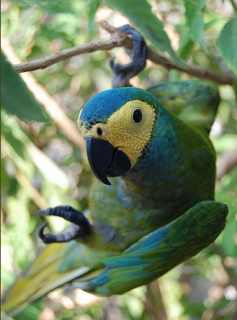Red-bellied Macaw |
|
|
Photos
View in GalleryDid You Know?
Red-bellied macaws are one of the most difficult parrots to breed in captivity due to their lack of ability to adapt to captive conditions.Academic Research
Related publications: Orthopsittaca manilatusSpecies Profile
Genus: Orthopsittaca | Species: manilatus
Size:
46cm (18 in)
Weight:
300g (10.5 oz)
Subspecies including nominate:
one
Colour Adult:
Both adults medium sized green macaws with roughened skin on bare yellow face; blue wash on forecrown; grey scalloping pattern on green chest; brown/red mid abdomen to vent; dull yellow on underwings and undertail. Bill grey/black. Eye brown.
Colour Juvenile:
As in adult but upper mandible grey, lower mandible pale grey.
Call:
High-pitched; wailing in flight. Other notes loud and rhythmical. Purring sounds while feeding. Flocks may be loud.
Listen NowMore Information:
Content Sources:
CITES
BirdLife International
Cornell Lab of Ornithology/Birds of the World
A Guide to Parrots of the World, Juniper and Parr, 1998.
ML Media Collection Catalogue 29346, Red-bellied Macaw Orthopsittaca manilata, Parker, Theodore A., III, Loreto, Peru, Jun. 1 1982, Cornell Lab of Ornithology. Site
Parrots of the World, Forshaw and Cooper, 1977.
Parrots of the World, Forshaw, 2006. 2010 edition
Parrots in Aviculture, Low, 1992.
Parrots: Their Care and Breeding, Low, 1986.
Psittacine Aviculture, Schubot, Clubb and Clubb, 1992.
Photos
View in GalleryDid You Know?
Red-bellied macaws are one of the most difficult parrots to breed in captivity due to their lack of ability to adapt to captive conditions.Academic Research
Related publications: Orthopsittaca manilatusSpecies Care
Captive Status:
Uncommon
Longevity:
May live up to 40 yrs in the wild.
Housing:
Aviary or suspended enclosure, minimum length 4m (13.1 ft), or 3m (9.8 ft) for breeding with access to larger flight for rest of year.
Diet:
Mixture of small seeds; canary, oats, safflower, millet spray, limited sunflower; sprouted mung beans, cooked butterbeans and lentils; corn on the cob, green leaves of spinach, Swiss chard, lettuce, sowthistle, dandelion and chickweed, emphasis on fresh fruit and vegetables daily, palm fruits if available; nuts: walnuts, hazelnuts, pecans, roasted peanuts, complete pellet for macaws.
Enrichment:
Are chewers; always provide bird-safe wood (fir, pine, willow and elder) and limbs for them to chew; heat sterilized pine cones, vegetable tanned leather toys. Enjoys bathing, so provide overhead misters or shallow water bowls.
Nest Box Size:
12" x 12" x 18" (30.5cm x 30.5cm x 46cm) vertical box.
Clutch Size:
2 to 4
Incubation Time:
25 days
Fledging Age:
11 weeks
Hatch Weight:
13g (0.45 oz)
Peak Weight:
Not recorded.
Weaning Weight:
Not recorded.
Photos
View in GalleryDid You Know?
Red-bellied macaws are one of the most difficult parrots to breed in captivity due to their lack of ability to adapt to captive conditions.Academic Research
Related publications: Orthopsittaca manilatusSpecies Wild Status
World Population:
Unknown, stable.
IUCN Red List Status:
Least Concern
CITES Listing:
Appendix II
Threat Summary:
Not globally threatened. Locally common throughout range with the exception of Colombia and Guyana, the latter of which sees local trapping of the birds. In Venezuela, destruction of palms for industry has caused a significant decline in population.
Range:
Trinidad, Guianas, E Venezuela to S Colombia, E Ecuador, E Peru, N Bolivia to Amazonian Brazil.
Habitat:
Found up to 500m (1640 ft); dependent on the Moriche palm (Mauritia flexuosa), which are found in swampy or seasonally flooded areas; also found in dense moist forest, gallery forest and open savannas and grasslands.
Wild Diet:
Feeds mostly on Moriche palm (Mauritia flexuosa) fruits, but berries and other fruits, especially Euterpe and Roystonea oleracea, are taken.
Ecology and Behaviour:
Gregarious birds with flocks of up to 100 reported, roosts in Moriche palms (Mauritia flexuosa), occasionally nomadic into cultivated areas.
Clutch and Egg Size:
2 to 4, ellipitical eggs, 42.5 x 27.0mm (1.6 x 1 in).
Breeding Season:
Trinidad: February and September. Colombia: February-May. Guyana: February-June. Nest is a hollow in a stump or fallen log.
Related Links:
Photos
View in GalleryDid You Know?
Red-bellied macaws are one of the most difficult parrots to breed in captivity due to their lack of ability to adapt to captive conditions.Academic Research
Related publications: Orthopsittaca manilatusMembers Only Resources
Please log-in now to find more research, resources and tools.
Not a Member?
Find more great information:
Gain exclusive access to 600+ pages of additional research, seminars and podcasts, specialists to ask your toughest questions, and dozens of other fun resources - when you become a WPT member.
Join Today >>

































